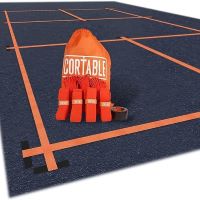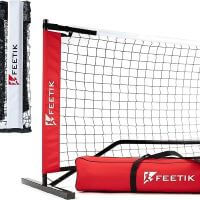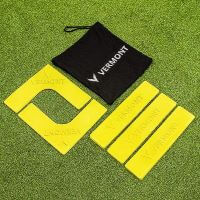Are you looking to build an outdoor pickleball court in the backyard?
Building an outdoor pickleball court isn’t as difficult as it may seem. There are several important steps that need to be taken. From measuring the area and gathering materials to leveling the ground and laying the surface.
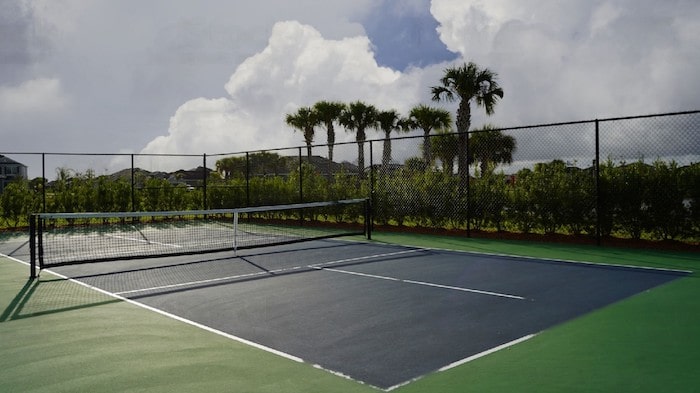
This guide will walk you through all the necessary steps for building an outdoor pickleball court.
With careful planning and preparation, you can create a safe and enjoyable playing environment for yourself and others.
You Might Also Like:
Steps to Build an Outdoor Pickleball Court
Building an outdoor pickle ball court requires careful planning. As there are some important steps you need to look at. In order to build a court that meets the official USAPA regulations.
From selecting the right materials and finding the perfect spot for your court, all the way through marking out lines and installing net posts. This guide will provide you with all the steps necessary to build a safe and fun outdoor pickle ball court.
1. Determine the Size
The size of an outdoor pickleball court is a regulation 20 feet wide by 44 feet long. The lines that divide the court are 2 inches wide and should be painted or taped onto the surface. Each side of the court should have a 7 foot non-volley zone in front of it, also known as the “kitchen”, which should be clearly marked off. The net should be 36 inches high in the center and 34 inches at each post.
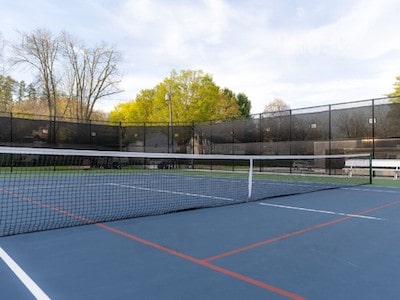
2. Choose the Court Surface Material
When choosing the surface material for your outdoor pickleball court, it is important to consider the environment in which you are playing.
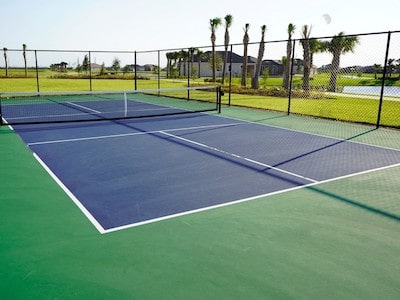
The most commonly used surfaces are concrete, asphalt, and clay. Concrete offers a durable and low-maintenance option that is ideal for areas with moderate weather conditions. Asphalt is best suited for warm climates as it can become slippery when wet and may be prone to cracks during freezing temperatures.
Clay surfaces provide excellent traction but require more maintenance than other options due to the need to level out low spots in order to maintain consistent playability.
3. Obtain Necessary Permits and Zoning Approvals
In order to build an outdoor pickleball court, it is important to obtain all necessary permits and zoning approvals from the local government. Depending on the size of the court and its location, permits may be required for activities such as excavation, earth moving, or construction.
Furthermore, it is important to check with local zoning regulations prior to beginning any construction project in order to ensure that building an outdoor pickleball court is allowed in your area.
4. Pick Out Perimeter Fencing
Perimeter fencing is an important step to consider when building an outdoor pickleball court. Fencing can be used to not only keep the ball within the playing area but also can provide safety for those playing.
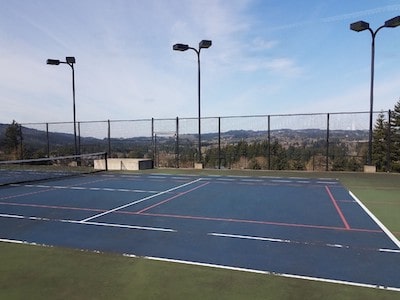
When selecting a type of fence, ensure that it meets the necessary height requirements and is made of durable materials that will withstand weather conditions. Additionally, opt for a fence design with small gaps between each slat so that you don’t have to worry about balls getting stuck in between them.
Also, read blogs on:
- Pickleball tactics to improve your game
- How to score in pickleball.
5. Install the Net and Posts
One of the steps to building an outdoor pickleball court is to install the net. Start by placing two poles in the ground on either side of the court, approximately 30 feet apart and 4–6 inches into the ground.
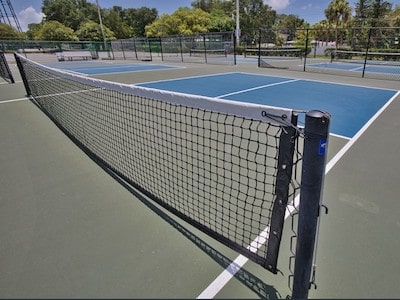
Make sure that they are level with each other and straight up and down. Attach a net or fence material between them at a height of 36 inches at its center, which is where it will attach to each pole. Stake down or secure both ends into place so that it doesn’t move while playing.
6. Add the Final Surface Layer
Adding the final surface layer is an important step to build an outdoor pickleball court. This layer should be a non-slip and weather-resistant material such as asphalt, concrete, or special sport court tiles.
The chosen material should be at least 2.5 centimeters thick in order to provide a safe and durable court surface. It is also important to make sure that the base underneath the top layer of material is firmly compacted so that it will not shift over time due to heavy use or environmental conditions.
7. Tape the Lines
Taping the lines is one of the key steps in building an outdoor pickleball court. It is important to accurately measure and mark the boundaries of your court before taping them with a durable outdoor grade masking or athletic tape.
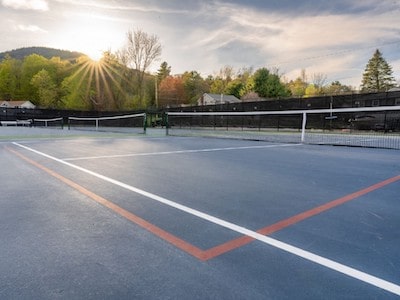
When measuring, make sure to double-check that your measurements are correct for accurate court play.
Additionally, make sure to use a paint roller for applying pressure, when you tape down each line. This will ensure that the lines stay in place for longer periods of time and provide an even look.
How Much Does It Cost to Build a Pickleball Court?
The cost of building a pickleball court can vary greatly depending on the size and type of surface you choose. Generally, the cost to build a court ranges from $3,000 to $20,000 or more.
This includes surface materials, netting, posts and poles, and other necessary accessories. The most popular surface choice is concrete, which provides a permanent solution that is low maintenance, but expensive when compared to other surfaces like asphalt or acrylic paint.
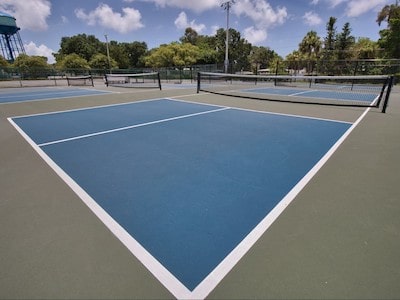
Asphalt may be cheaper initially but requires periodic resurfacing, which can add up in costs over time. Acrylic paint offers an inexpensive way to build a court with minimal effort in terms of upkeep, but it’s not as durable as concrete or asphalt, so will require more frequent repainting.
Furthermore, additional costs such as fencing may need to be considered when building your pickleball court, making it even more expensive depending on your individual needs and preferences.
FAQs
The best surface for outdoor pickleball is one that provides good grip, shock absorption, and consistent playing characteristics. A textured concrete or asphalt court with a medium to coarse grit finish is generally considered the ideal surface for outdoor play. Acrylic sport surfacing systems are also an option, as they provide superior traction and shock absorption. Other options include clay courts, synthetic turf, rubber surfaces, and artificial grass.
A pickleball court should have a concrete base that is at least 4 inches thick. This thickness ensures the surface will be able to withstand the rigorous use of pickleball games. The concrete should be poured and leveled, so the court lines can be clearly seen on it. It is also important to make sure that all debris, dust, and dirt are removed from the court before playing begins.
Outdoor pickleballs have more holes than indoor pickleballs to improve visibility and performance. The additional holes provide better air circulation and help the ball to move more freely through the air. This helps players to track the ball easier as it moves across the court, allowing them to make better shots. The extra holes also reduce wind resistance, making it easier for players to hit shots with power and accuracy.
A regulation-sized pickleball court is 20 feet by 44 feet, for a total of 880 square feet. This includes the court itself and an area of at least 6 feet all around it. To ensure adequate space for movement and safety, it is recommended to have at least 15-20 additional feet beyond the baseline and sidelines of the court.
Start by measuring the area you’d like to use for the court and marking it off with strings or flags. Make sure that you leave enough space for players to move around freely. Next, clear out any debris from the area such as rocks, sticks, or leaves.
Well, It’s a Wrap!
Building an outdoor pickleball court can be a fun and rewarding project. Not only does it provide hours of entertainment, but it also adds aesthetic value to your home or business.
There are many things to consider when creating an outdoor pickleball court, including cost, location, size, and materials. The most important step is planning ahead to make sure all required permits are obtained and that the space meets all local regulations.

I am the founder of BallSportsPro, a popular pickleball resource for players of all levels. I am a former professional tennis player, started playing pickleball in 2009 and quickly fell in love with the game. I launched BallSportsPro in 2018 to share my passion for the sport and to provide pickleball players with the latest news, tips, and gear reviews. Today, BallSportsPro is one of the most popular pickleball resources on the web, reaching hundreds of thousands of players each month. In addition to running the website, I also a regular contributor to Pickleball Magazine and a member of the USAPA Pickleball Ambassadors program.

